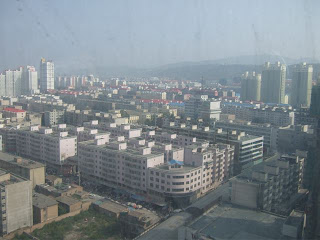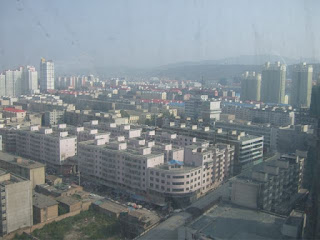Crossing the empty spaces: Xining to Lhasa
So the story to tell now is how I traversed the great empty spaces between Xining and Lhasa, the capital of Tibet. In the past, the only overland route for such a journey would have involved days on a crowded bus over narrow treacherous roads, if you were lucky enough to get a travel permit. Lhasa is high on the Tibetan plateau, at an altitude of 3400m, and getting there in olden days was well-nigh impossible. Tibet was a real mountain kingdom, a distant inaccessible land.
Of course all that has changed. In the last year the Chinese government has finished an enormous construction project, costing billions of dollars, with the ultimate aim of linking Lhasa and Beijing by railway. The part of the railway between Goldmud and Lhasa was opened this year, and now each evening at ten a train arrives carrying voyagers from the other side of the Tibetan plateau. This was the train that I took, from Xining. A voyage which lasted around 25 hours and reached in places altitudes of 5000 metres…
Last Friday evening a small group of us assembled on the steps of Xining train station and were taken to the train by our Chinese guides, through an incredible press of people. The train was making a brief stop in Xining before continuing on to Lhasa, and this was where we boarded. There was around twelve of us in our group, and all of us had been in Xining for a conference. I found easily enough my narrow bed, one of six, in a small cabin. My cabin companions were polite but spoke no english. Although it was only 10.30pm in the evening, the easiest thing to do was to do go to sleep; there was nothing else to do. And sleep came rapidly, thanks to the rocking of the train on the rails. We were travelling at a leisurely sixty kilometres an hour towards Lhasa. A short time after I had stretched out in my bed (miraculously I had space enough for that) the wagon guard drew the curtains and turned off the lights.
The next morning I awoke somewhat abruptly to the muffled strains of Chinese martial music. The lights were on once more, the curtains drawn. Time to wake up. I struggled from my bed and peered out. An arid, desolate landscape scrolled past the windows, flat and uninhabited. Absolutely nothing was visible in all directions. At each window down the length of the car, Chinese tourists were avidly taking photographs and video footage. Or preparing breakfast. Each wagon featured an abundant supply of hot water and throughout the journey passengers were constantly making tea or noodles. None of that for me! I located an electric socket on the train and before too long I was preparing espresso in my ‘moka electrika’; real coffee is almost impossible to find in China.
The train stopped at Golmud, and the public address system informed us in great detail (with many precise statistics) of the virtues of this completely lost city, what mineral resources were available, how many people lived there. How it was an essential staging post for the construction of the Beijing-Lhasa railway. We had a few minutes in the rain on the platform before before boarding the train once more. I don’t think anyone got on the train. Between these public service announcements throughout the voyage we were subjected to a bewildering variety of music, from Chinese pop to pseudo-tibetan folk music to marching music, all at an ear-splitting volume. Luckily I had my ear-plugs. I suppose the music selection was designed to inspire us when confronted with this vast land. I soon realised that many Chinese on the train were humming the airs sotte voce throughout the journey.
Our altitude slowly increased. I became gradually aware of a hissing noise everywhere throughout the train. Although the cabins were not pressurised, they were oxygenated, and a steady flow of gas came from nozzles in each cabin. I began to feel slightly light-headed from the thinness of the air. I am sure that our week in Xining, altitude 2000 metres, had helped us to acclimatise, but still.
Now there were salt flats sliding past the cabin windows, great expanses of the whites and browns. The PA system informed us of the immense difficulties that had been overcome to lay train-tracks over this barren wasteland. Every so often, we passed a row of green huts and trucks: Chinese military barracks, each one more remote than the last. I imagined sleeping and working there, the extreme remoteness of it all. It was the only form of habitation we saw.
Next there were mountains with snow; and then were surrounded by snow-fields and glaciers. Freezing clouds enveloped the train; our altitude was now well above 4000 metres. We were higher than the summit of Mauna Kea. We were travelling over the permafrost, and the cabin loudspeakers told us what a feat of engineering it was to lay train tracks on ground which shifts and melts, which isn’t really solid at all.
The snow receded, we were crossing grasslands. A lake, an enormous limitless lake appeared, beautiful blue-green waters stretching impossibly far away. The world’s highest freshwater lake, we were told. After that, signs of habitation became visible. We stopped at brand new stations constructed in the middle of unending wilderness; the train doors did not open, presumably because of the incredible altitude. Passengers might faint on the platform. Station Na Qu, for example, at 4,513 metres above sea level. I felt almost as if I was in a spaceship, travelling through hostile alien lands with no breathable atmosphere.
A few more scattered habitations became visible, huts lost in the plain. I remember seeing two men lying beside their motorcycle, watching the train go past. I tried to imagine what life must have been like in this land before the train arrived. What life must be like now. Then darkness fell, and after another six or so hours of travel, we arrived in Lhasa. The train station, an enormous modernist structure, was brand new, and far outside the town, so we had no sense of the city when we arrived. That would have to wait until the next day.

